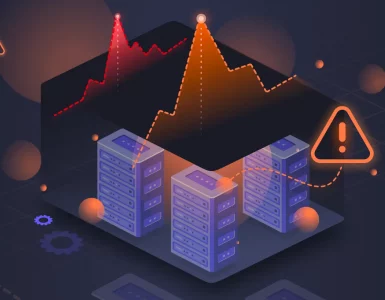Modern IT environments composed of multi-cloud infrastructure, microservices and containerized applications present immense complexity for DevOps teams to manage. Lacking visibility leads to critical outages and performance issues. Robust monitoring and analytics tools provide the actionable insights DevOps engineers need to work efficiently across interconnected domains.
But with a multitude of solutions on the market, how do you know whether an AIOps-driven platform like Motadata or a specialized network monitor such as SolarWinds NPM best fits your use case? This in-depth feature comparison breaks down the core capabilities, recommended deployment scenarios and key differentiators engineers should consider when evaluating both monitoring options.
In this article by the Talent500 expert panel, we will compare Motadata AIOps and SolarWinds NPM based on the reviews shared by their respective users on platforms like Capterra, G2, TrustRadius, and more.
Let’s begin:
Motadata Delivers Broad Observability and AIOps Intelligence
Motadata AIOps shouldn’t be narrowly pigeonholed as just another ITIM solution. It constitutes an entire ITOps platform spanning infrastructure monitoring, log analytics and network observability augmented by embedded AIOps capabilities. The universal Motadata agent offers a single pane of glass consolidating insights across this breadth—the lack of data silos empowers accurate service delivery visualization even for complex, heterogeneous environments.
But Motadata’s crown jewel comes via its Deep Learning Framework for IT Operations (DFIT) underpinning predictive AIOps. Noise reduction isolates actionable signals. Anomaly detection identifies events warranting attention. Sophisticated correlation spotlights connections between incidents. By ingesting myriad data types and leveraging advanced analytics, Motadata provides comprehensive observability for infrastructure, apps and services along with the automated intelligence to make this visibility actionable.
SolarWinds NPM Brings Purpose-Built Network Monitoring
SolarWinds NPM, on the other hand, focuses specifically on delivering robust network performance monitoring and troubleshooting. It concentrates on providing network engineers visibility into availability, fault status, device health, traffic analysis and other network-centric signals. For admins working primarily within networking domains rather than broader infrastructure, NPM brings specialized tooling to optimize architecture and connectivity.
For example, intelligent mapping visualizations illuminate how the numerous devices comprising corporate networks interrelate for quick diagnosis of issues and bottlenecks. Automated workflows simplify configuring alerts tailored to different network faults or traffic conditions. SolarWinds NPM fits organizations needing network performance insights beyond what integrated infrastructure monitoring provides.
Key Evaluation Criteria Comparing Platform Capabilities
With an understanding of Motadata and SolarWinds’ approaches, we can establish comparative criteria to guide which better aligns to specific use cases:
- Holistic infrastructure monitoring – Motadata AIOps
- Network-focused visibility – SolarWinds NPM
- AIOps/ML intelligence – Motadata AIOps
- Custom topological mapping – SolarWinds NPM
- Consolidating data siloes – Motadata AIOps
- Traffic flow optimization – SolarWinds NPM
- issue correlation across domains – Motadata AIOps
- Multi-vendor network support – SolarWinds NPM
- Automation integration via API – Motadata AIOps
Determining which platform fits best involves assessing factors like existing tooling, admin skill sets, use of Cisco gear, scale requirements and hybrid vs cloud. Many larger enterprises adopt both Motadata and SolarWinds for infrastructure vs network visibility. But for most, aligning monitoring approaches to core visibility gaps proves the smarter path.
Detailed Feature Comparison
This chapter will do a head-to-head evaluation of the monitoring capabilities, analytics, ease of use, flexibility and other core features of Motadata AIOps vs SolarWinds NPM to highlight key distinctions:
Monitoring Scope & Data Collection
Motadata provides comprehensive, unified observability spanning infrastructure, apps, networks and services through its universal agent. Out-of-the-box support automatically monitors 100+ applications and systems. Custom dashboards integrate metrics, logs and other data sources.
SolarWinds NPM focuses exclusively on network monitoring, covering availability, traffic analysis, device health, performance metrics and more. It leverages standards like SNMP, NetFlow and WMI to poll managed network infrastructure.
Analytics & Intelligence
Motadata AIOps applies machine learning techniques like anomaly detection, noise reduction, forecasting and intelligent alert correlation. The Deep Learning Framework for IT Operations (DFIT) processes signals from across domains to provide meaningful insights.
SolarWinds NPM analytics concentrate specifically on identifying network issues, performance degradation and bandwidth bottlenecks. Intelligent mapping and visualization present the current state of network infrastructure and traffic.
Ease of Use & Flexibility
Motadata AIOps provides an intuitive centralized interface to monitor and manage IT infrastructure, apps, logs and networks. Custom dashboards and role-based access accommodate diverse teams. API integrations connect AIOps data and actions to other platforms.
SolarWinds NPM’s web console simplifies monitoring, troubleshooting and managing networks for IT administrators through automated workflows. Wizards guide device discovery and configuration. Orion Maps visualize fault domains and dependencies.
Implementation Factors to Consider
Deploying enterprise-grade monitoring platforms requires careful evaluation of architectural options, sizing, administration needs and integration plans:
Deployment Architecture
Motadata AIOps supports on-premises, cloud and hybrid deployments. The web interface, universal agent and analytics engine can flexibly monitor infrastructure across environments.
SolarWinds NPM deployments are typically on-premises leveraging Customer Experience Databases that synchronize monitoring data. Cloud-based instances are available but may have reduced capabilities.
Sizing & Scalability
Motadata AIOps offers dynamic scalability to grow from monitoring handfuls to thousands of nodes. The distributed architecture supports large volumes of metrics, events and log data out of the box.
SolarWinds NPM can scale to tens of thousands of network devices and interfaces. Larger deployments may require distributing pollers across servers and optimizing database performance. Cloud deployments have lower scaling limits.
Administration & Configuration
Motadata AIOps aims to minimize setup time via auto-discovery of infrastructure and apps. Wizards guide tying monitoring data to log sources. AI and ML features like anomaly detection work out of the box.
SolarWinds NPM eases network monitoring setup by auto-discovering devices and interfaces. Domain managers configure monitoring of fault, performance and availability. Custom network maps and hierarchies simplify administration.
Integrations & Open API
Motadata AIOps includes 150+ third-party integrations with ITSMs like ServiceNow, ticketing systems and collaboration tools. The REST API enables tying advanced analytics into other platforms.
SolarWinds NPM leverages standard protocols like SNMP for broad device support. API integrations exist for IT ticketing, security, network automation and other specialized tools.
Customer Use Cases and Reviews
Real-world examples and user experiences showcase how Motadata’s AIOps capabilities and SolarWinds’ network monitoring solutions are deployed by IT organizations:
Motadata AIOps
A large retailer consolidated their disjointed monitoring tools with Motadata AIOps. The universal agent eliminated data silos and reduced incident resolution times by over 30%, as noted in an August 2023 G2 review.
An IT services provider adopted Motadata for customizable multi-tenant dashboards and alerting. A January 2024 review on G2 confirmed Motadata’s ability to package monitoring across domains for multiple customers.
SolarWinds NPM
A hospital system with regional locations uses SolarWinds NPM for consistent network monitoring. An October 2023 G2 review cited NPM’s reliability for ensuring uptime across sites.
A software firm with thousands of VMs and a complex hybrid environment deployed SolarWinds NPM when their legacy tool couldn’t scale. A February 2023 G2 review validated NPM’s capacity to unify visibility for network traffic and devices.
Summing Up: Which Tool is The Right Fit?
With an understanding of Motadata AIOps and SolarWinds NPM’s respective strengths and weaknesses, we can establish guideline criteria to determine which solution best fits specific monitoring needs:
- Organizations primarily concerned with infrastructure and application performance should lean towards Motadata AIOps for its unified observability and advanced AIOps-powered analytics spanning metrics, logs and network data.
- Network-centric IT teams caring specifically about optimizing corporate networks, connectivity and traffic should skew towards SolarWinds NPM’s purpose-built network monitoring capabilities.
- Environments encompassing multi-vendor networks, significant Cisco footprint and need for customized hierarchical network mapping may favor SolarWinds NPM.
- Companies looking to consolidate disjointed monitoring solutions will benefit from Motadata AIOps universal data ingestion supporting centralized visibility and insights.
- Organizations needing scalable monitoring-as-a-service for multi-tenant customers should consider Motadata AIOps customizable dashboards and role-based access control.
- On-premises focused IT with primarily Windows-based infrastructure, leveraging Active Directory and desiring .NET customizations can choose SolarWinds NPM.
The above criteria combine with factors like budget, in-house skill sets, SI partnerships and more to determine the best AIOps and network monitoring fit. Hybrid deployment using domain-based tools from both solutions is also an option for organizations requiring capabilities from each.
Are you looking for a high TC job? Also, want it to be remote?
Sign up on Talent500 now!






Add comment